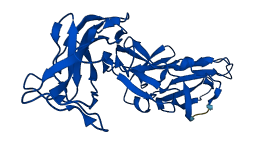A0A0R4I961
Gene name |
ECP_4655 |
Protein name |
FimH protein |
Names |
|
Species |
Escherichia coli F18+ |
KEGG Pathway |
|
EC number |
|
Protein Class |
FIMBRIAL SUBUNIT ELFA-RELATED (PTHR33420) |

Descriptions
The Escherichia coli fimbrial adhesive protein, FimH, mediates shear-dependent binding to mannosylated surfaces via force-enhanced allosteric catch bonds. The anchoring (pilin) domain (155-279) of FimH interacts with the mannose-binding (lectin) domain, causing a twist in the b sandwich fold of the mannose-binding domain. This loosens the mannose-binding pocket on the opposite end of the lectin domain, resulting in an inactive low-affinity state of the adhesin.
Autoinhibitory domains (AIDs)
Target domain |
1-158 (Mannose-binding domain) |
Relief mechanism |
Others |
Assay |
Mutagenesis experiment, Structural analysis |
Accessory elements
No accessory elements
Autoinhibited structure
Activated structure

No variants for A0A0R4I961
| Variant ID(s) | Position | Change | Description | Diseaes Association | Provenance |
|---|---|---|---|---|---|
| No variants for A0A0R4I961 | |||||
No associated diseases with A0A0R4I961
Functions
| Description | ||
|---|---|---|
| EC Number | ||
| Subcellular Localization |
|
|
| PANTHER Family | PTHR33420 | FIMBRIAL SUBUNIT ELFA-RELATED |
| PANTHER Subfamily | PTHR33420:SF11 | TYPE 1 FIMBRIN D-MANNOSE SPECIFIC ADHESIN |
| PANTHER Protein Class | ||
| PANTHER Pathway Category | No pathway information available | |
1 GO annotations of cellular component
| Name | Definition |
|---|---|
| pilus | A proteinaceous hair-like appendage on the surface of bacteria ranging from 2-8 nm in diameter. |
No GO annotations of molecular function
| Name | Definition |
|---|---|
| No GO annotations for molecular function |
1 GO annotations of biological process
| Name | Definition |
|---|---|
| cell adhesion | The attachment of a cell, either to another cell or to an underlying substrate such as the extracellular matrix, via cell adhesion molecules. |
No homologous proteins in AiPD
| UniProt AC | Gene Name | Protein Name | Species | Evidence Code |
|---|---|---|---|---|
| No homologous proteins | ||||
| 10 | 20 | 30 | 40 | 50 | 60 |
| FACKTANGTA | IPIGGGSANV | YVNLAPAVNV | GQNLVVDLST | QIFCHNDYPE | TITDYVTLQR |
| 70 | 80 | 90 | 100 | 110 | 120 |
| GSAYGGVLSS | FSGTVKYNGS | SYPFPTTSET | PRVVYNSRTD | KPWPVALYLT | PVSSAGGVAI |
| 130 | 140 | 150 | 160 | 170 | 180 |
| KAGSLIAVLI | LRQTNNYNSD | DFQFVWNIYA | NNDVVVPTGG | CDVSARDVTV | TLPDYPGSVP |
| 190 | 200 | 210 | 220 | 230 | 240 |
| IPLTVYCAKS | QNLGYYLSGT | TADAGNSIFT | NTASFSPAQG | VGVQLTRNGT | IIPANNTVSL |
| 250 | 260 | 270 | |||
| GAVGTSAVSL | GLTANYARTG | GQVTAGNVQS | IIGVTFVYQ |